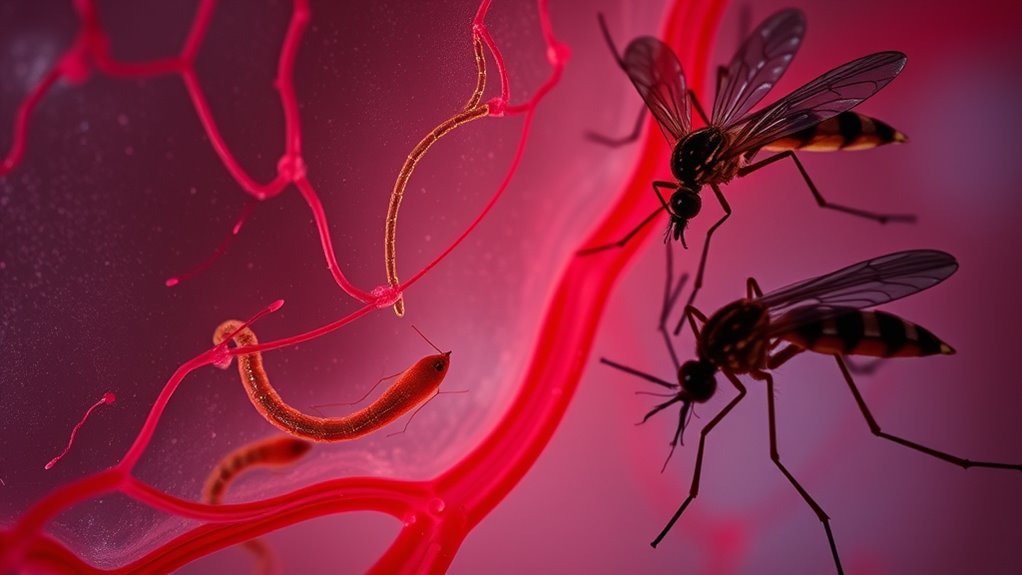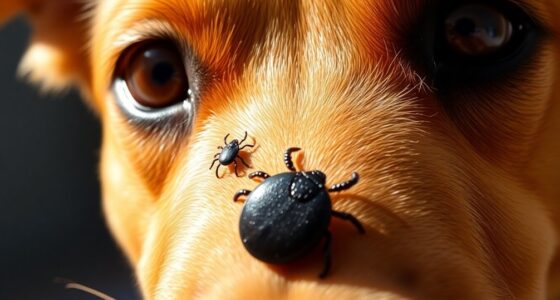To understand the heartworm lifecycle and prevention, know that microfilariae circulate in your pet’s blood and develop inside mosquitoes. When a mosquito bites, it transmits infective larvae, which mature into adult worms over a few months, producing more microfilariae. Preventing heartworm involves controlling mosquito exposure, eliminating breeding sites, and giving your pet veterinarian-recommended preventive medication regularly. Staying vigilant guarantees early detection and protection—discovering more will help you keep your pet safe from this deadly disease.
Key Takeaways
- Microfilariae circulate in the bloodstream and develop into infective larvae within mosquitoes over 10-14 days.
- Mosquitoes transmit infective larvae to new hosts during blood meals, starting the infection cycle.
- Larvae mature into adult heartworms in the heart and lungs over 2-3 months, producing microfilariae.
- Preventive medications, mosquito control, and eliminating standing water reduce infection risk.
- Early diagnosis via blood tests and prompt treatment prevent severe health complications.
The Heartworm Lifecycle Begins: The Role of Mosquitoes

Mosquitoes are essential to the start of the heartworm lifecycle because they serve as the primary vectors that transmit the disease. When mosquitoes breed in stagnant water, they multiply rapidly, increasing the chances of spreading heartworm larvae. During a blood meal, an infected mosquito transfers infective larvae into your pet’s bloodstream. This process is critical because it kicks off the entire lifecycle. However, some regions experience heartworm resistance, making disease prevention more challenging. Resistant heartworms can survive traditional treatments, emphasizing the importance of controlling mosquito populations and practicing regular prevention. By reducing mosquito breeding sites around your home and staying vigilant, you can minimize your pet’s risk of infection and help interrupt the cycle before it begins.
Microfilariae: The Early Stage Inside the Host
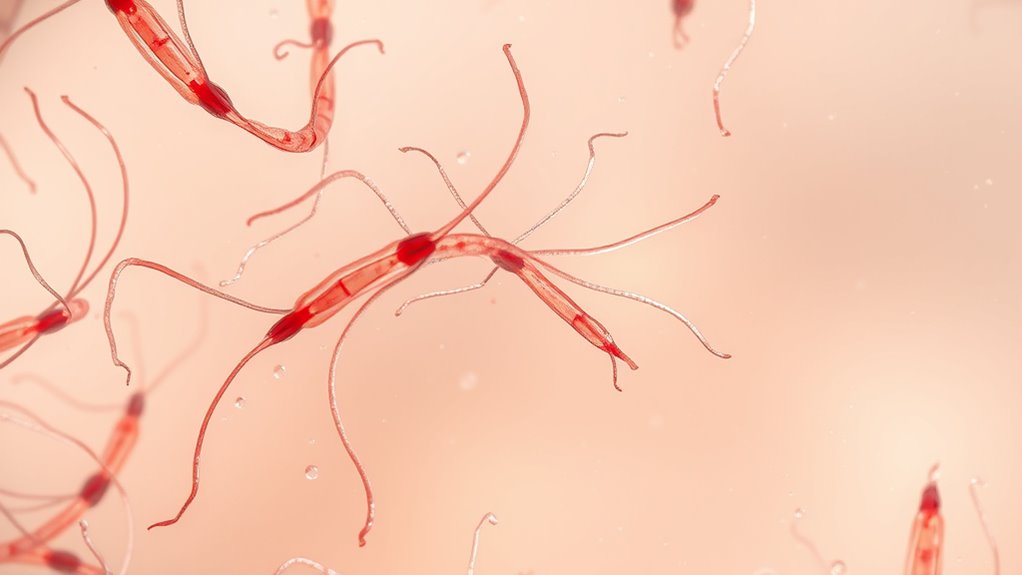
Once inside your pet’s bloodstream, immature heartworm larvae, called microfilariae, begin their early development stage. During microfilariae development, they circulate freely, making them vulnerable to your pet’s host immune response. Your pet’s immune system detects these foreign organisms and works to attack them, which can influence their survival and further development. The microfilariae are small, measuring about 300 micrometers, and their presence signals active infection. To better understand this process, consider the following:
| Microfilariae Development | Host Immune Response |
|---|---|
| Circulate in bloodstream | Immune system detects foreign entities |
| Approx. 300 micrometers | Attacks and neutralizes some microfilariae |
| Early development inside host | Can limit further heartworm progression |
| Vulnerable stage | Effectiveness varies among pets |
| Critical for transmission | Influences disease severity |
Additionally, the immune response can vary significantly based on individual health factors and prior exposure.
Mosquitoes as Vectors: How They Transmit Heartworms
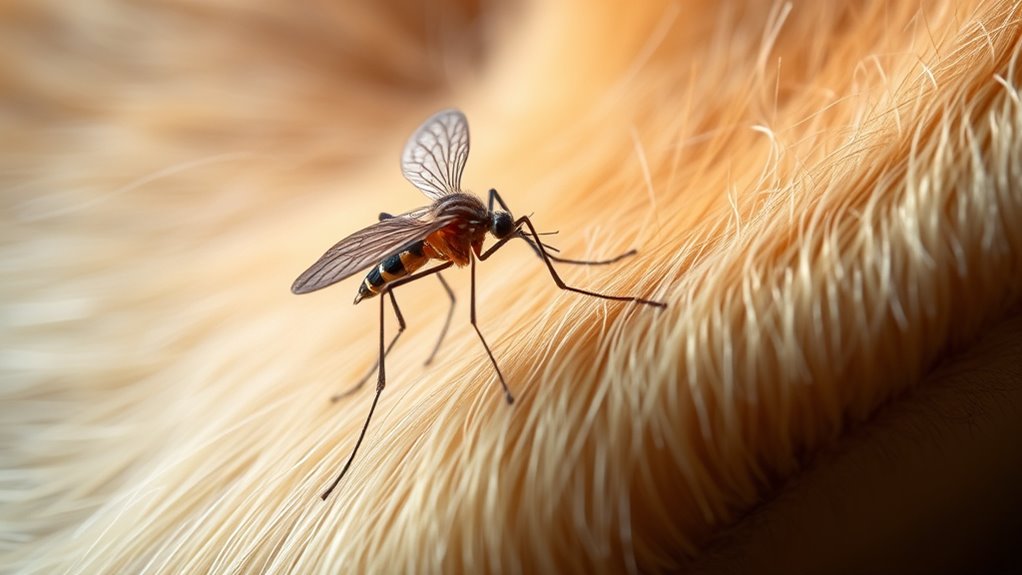
Vampire-like insects play a critical role in the transmission of heartworms from infected animals to your pet. Mosquitoes become vectors when they feed on an infected host, ingesting microfilariae. These parasites develop inside the mosquito during their breeding cycle. When the mosquito bites again, it transmits infective larvae to your pet’s bloodstream, continuing the heartworm lifecycle. To protect your pet, it’s imperative to control mosquito breeding around your home, eliminating standing water where they breed. Regular heartworm medication is also indispensable, as it prevents larvae from developing into adult worms if your pet is bitten. Mosquito control methods can significantly reduce the risk of transmission. By reducing mosquito populations and maintaining consistent heartworm prevention, you lower your pet’s risk of infection and keep them safe from this dangerous parasite. Additionally, understanding the heartworm lifecycle helps pet owners take proactive measures to prevent infection. Ensuring proper mosquito habitat management can further decrease the chances of transmission.
Development Inside the Mosquito: The Maturation Process
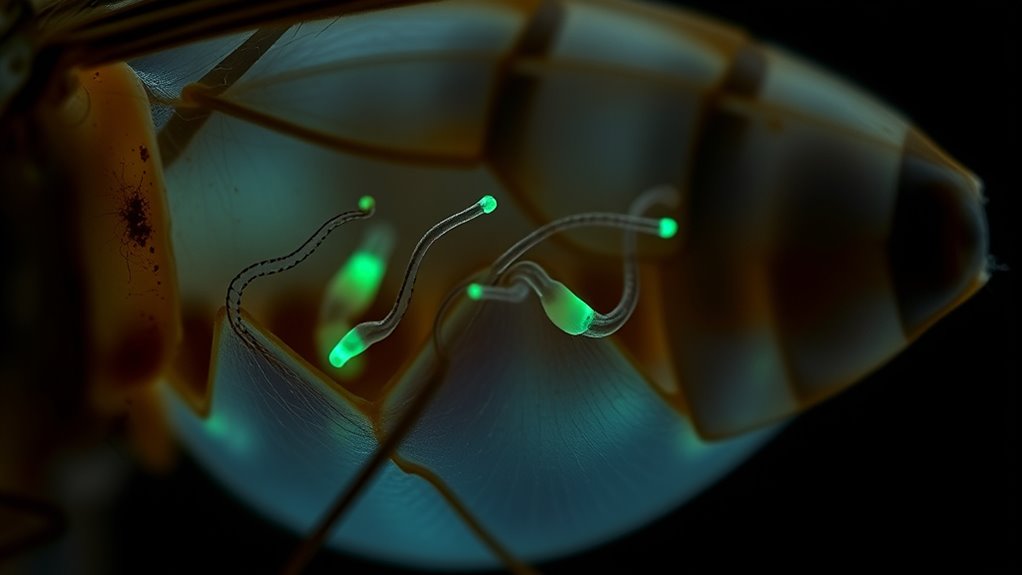
After a mosquito ingests microfilariae during a blood meal, these tiny parasites begin their complex development inside the insect. They travel through the mosquito’s anatomy, mainly the midgut and Malpighian tubules, where larval development occurs. During this process, the microfilariae transform into infective larvae through key stages:
- Migration: Larvae move from the midgut to the mosquito’s thoracic muscles. Larval migration is a critical step facilitated by the mosquito’s internal anatomy.
- Maturation: They develop into infective third-stage larvae over 10-14 days. The maturation period is influenced by environmental factors like temperature. Development timeline can vary based on external conditions.
- Readiness: Once matured, these larvae migrate to the mosquito’s mouthparts, ready for transmission during the next blood meal.
- Headphone Compatibility: The mosquito’s anatomy, including the mouthparts, is specially adapted to facilitate larval migration, similar to how headphone jacks connect devices for seamless audio transfer.
Understanding this process highlights how the mosquito’s anatomy facilitates larval development, setting the stage for heartworm transmission.
Infection of a New Host: The Transmission Phase
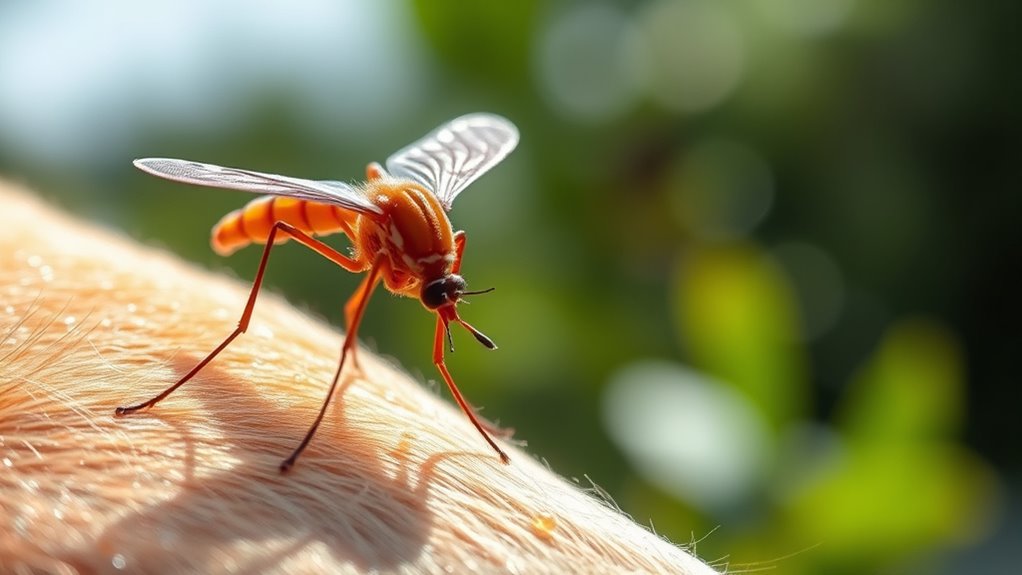
When a mosquito with mature infective larvae takes a blood meal from a new host, it initiates the transmission phase of heartworm infection. This process is known as vector transmission, where the mosquito acts as the carrier, transferring larvae into your pet’s bloodstream. During the bite, the larvae are deposited onto the skin and then enter the host’s tissues. Once inside, they migrate through the tissues, starting the host infection process. The success of transmission depends on the mosquito’s ability to carry viable larvae and the timing of the bite relative to the larvae’s development. This phase is vital because it marks the beginning of the heartworm’s lifecycle within your pet, setting the stage for further development inside the host. Ensuring proper heartworm prevention measures can interrupt this transmission at an early stage. Additionally, understanding the vector transmission process can help pet owners take proactive steps to reduce exposure to infected mosquitoes, especially considering recent advancements in machine learning algorithms that improve our understanding of disease patterns and risks.
Maturation in the Host: From Larvae to Adult Heartworms

Once inside your pet’s body, the tiny larvae travel through tissues and muscles, gradually maturing into adult heartworms. During this heartworm maturation process, larval development progresses over several months. You should know that:
- The larvae move through your pet’s tissues, seeking blood vessels.
- They develop into infective L3 larvae within 1-2 months.
- After migrating to the heart and lungs, they mature into adults over the next 2-3 months.
- Using a professional voice can help educate pet owners about the importance of early prevention and treatment.
- Understanding the lifespan of heartworms aids in timing treatments and preventive measures.
Understanding this timeline helps you recognize the importance of early prevention. The larval development phase is critical, as it determines when adult heartworms can cause damage. Prompt treatment during or before this stage can prevent severe complications.
Reproduction and Microfilariae Production

Adult heartworms in your pet’s heart and lungs produce microfilariae, tiny larvae that circulate in the bloodstream. This process is a key part of heartworm reproduction, ensuring the parasite’s survival and spread. These microfilariae are often invisible to the naked eye but crucial for transmission. They travel freely, awaiting a mosquito bite to continue their lifecycle. Here’s a visual to understand their movement:
| Microfilariae in Bloodstream | Mosquito picks them up |
|---|---|
| Circulating freely | Inside mosquito |
| Ready for transmission | Develop into infective larvae |
| Lifecycle continues | Next host infected |
This cycle highlights why controlling microfilariae production is essential for preventing heartworm disease. Since high microfilariae counts can complicate treatment, early detection and prevention are vital.
Symptoms and Diagnosis of Heartworm Disease

Recognizing symptoms early can make a big difference in your pet’s health, so watch for signs like coughing, fatigue, or difficulty breathing. Diagnostic tests such as blood work and chest X-rays help confirm the presence of heartworms. Be aware that some symptoms may be mistaken for other conditions, so proper testing is essential for an accurate diagnosis.
Recognizing Symptoms Early
Have you noticed any subtle changes in your dog’s behavior or health? Early signs of heartworm disease can be easy to miss, but recognizing them is essential. Many heartworm myths suggest it’s only severe when advanced, but early symptoms are often overlooked. Watch for:
- Mild coughing or fatigue after activity
- Decreased stamina or reluctance to exercise
- Noticeable weight loss or breathing difficulties
Keep in mind, pet vaccination doesn’t protect against heartworms, so vigilance is key. If you spot these signs, consult your vet promptly. Early detection can prevent serious health issues. Don’t fall for heartworm myths that downplay the importance of regular checkups. Recognizing symptoms early is your best defense against this silent threat, especially since heartworm prevalence remains significant in many regions, underscoring the importance of parasite lifecycle awareness. Additionally, understanding the transmission process of heartworms can help pet owners take proactive measures. Regular testing and preventive medications are crucial components of an effective prevention strategy.
Diagnostic Testing Methods
How do veterinarians confirm whether your dog has heartworm disease? They typically use diagnostic testing methods like antibody testing and antigen testing. Antibody testing detects whether your dog’s immune system has responded to heartworm exposure, indicating possible infection. Antigen testing, on the other hand, identifies proteins from adult heartworms circulating in your dog’s blood, confirming an active infection. These tests are quick and reliable, often combined for accurate diagnosis. Veterinarians may recommend testing even if your dog shows no symptoms, especially in areas where heartworm is common. Early detection through these methods allows for prompt treatment and improves your dog’s chances of recovery. Remember, regular testing is essential for maintaining your pet’s health and preventing severe complications.
Common Misdiagnosis Signs
Because heartworm tests can sometimes produce false negatives or be mistaken for other conditions, it’s important to be aware of the symptoms that might suggest your dog has heartworm disease. Misdiagnosis confusion often occurs due to symptom overlap with other health issues. Watch for signs like:
- Persistent cough that worsens with activity
- Fatigue or reduced exercise tolerance
- Noticeable difficulty breathing or fainting
These symptoms can be mistaken for respiratory or cardiac problems, leading to delayed diagnosis. Recognizing these signs early helps avoid misdiagnosis confusion and ensures timely treatment. Since heartworm disease shares symptoms with other conditions, consult your veterinarian if you notice any of these warning signs, even if initial tests seem clear. Prompt attention can prevent severe complications. Additionally, understanding the heartworm lifecycle and transmission can aid in prevention efforts, and staying informed about diagnostic accuracy can further improve early detection and treatment outcomes.
Preventive Measures and Protecting Your Pets

To effectively protect your pets from heartworm infection, implementing preventive measures is essential. Start with regular veterinary check-ups and administering veterinarian-recommended heartworm preventives year-round. Proper diet management supports your pet’s overall health, strengthening their immune system to combat infections. Additionally, exercise restrictions during peak mosquito seasons can reduce exposure to infected insects. Keep your yard free of standing water and use screens on windows and doors to prevent mosquito entry. Avoid outdoor activities during dawn and dusk when mosquitoes are most active. These steps, combined with consistent medication routines, substantially lower your pet’s risk of contracting heartworm disease. Staying vigilant and proactive ensures your furry friend remains safe, healthy, and protected from this potentially deadly parasite.
Frequently Asked Questions
Can Heartworms Affect Animals Other Than Dogs and Cats?
You might wonder if heartworms can affect animals beyond dogs and cats. While primarily targeting these pets, interspecies transmission is possible, especially in areas with wildlife reservoirs like foxes, wolves, and coyotes. These animals can harbor heartworms, increasing the risk for other animals through mosquito bites. Protecting all animals in your area, including wildlife, helps reduce spread, even if dogs and cats are your main concern.
How Long Does It Take for Heartworms to Mature in a Host?
Did you know that the incubation period for heartworm development varies between 6 to 7 months? Once a host is bitten by an infected mosquito, it takes about this time for the larvae to mature into adult heartworms. During this period, the worms grow and reproduce, making early detection essential. So, if you’re concerned, regular testing and preventive measures can help protect your pet from this serious disease.
Are There Any Natural Remedies for Preventing Heartworm Infection?
You might wonder if natural remedies can prevent heartworm infection. While some believe herbal supplements and alternative therapies could help, there’s no solid scientific proof they work effectively. Relying solely on these methods isn’t recommended. Instead, you should stick with veterinarian-approved preventatives to ensure your pet stays protected. Combining proper medication with a healthy lifestyle offers the best defense against heartworm, giving you peace of mind.
What Environmental Factors Influence Mosquito Breeding and Heartworm Transmission?
You should know that environmental factors greatly influence mosquito breeding habitats and heartworm transmission. Standing water in places like puddles, birdbaths, or clogged gutters provides ideal breeding sites. Warm, humid climates accelerate mosquito activity and breeding. By reducing stagnant water around your home and being mindful of climate impact, you decrease mosquito populations and lower the risk of heartworm transmission to your pets. Staying vigilant helps protect your animals effectively.
Is It Possible to Have a Heartworm Infection Without Showing Symptoms?
Imagine a dog showing no signs of illness yet harboring heartworms—that’s an asymptomatic case. It’s totally possible to have a hidden infection, where your pet shows no symptoms but still carries heartworms. These hidden infections can go unnoticed until they cause serious health issues. Regular testing is vital because even without symptoms, your pet might be infected, making early detection and treatment essential for their health.
Conclusion
By understanding the heartworm lifecycle, you hold the power to protect your furry friend from this deadly threat. Think of mosquitoes as tiny, sneaky villains plotting to invade your pet’s body—unless you act! Regular preventatives are your shield, stopping heartworms in their tracks before they even have a chance to grow. Stay vigilant, stay proactive, and keep those pests at bay—your pet’s life depends on it!

